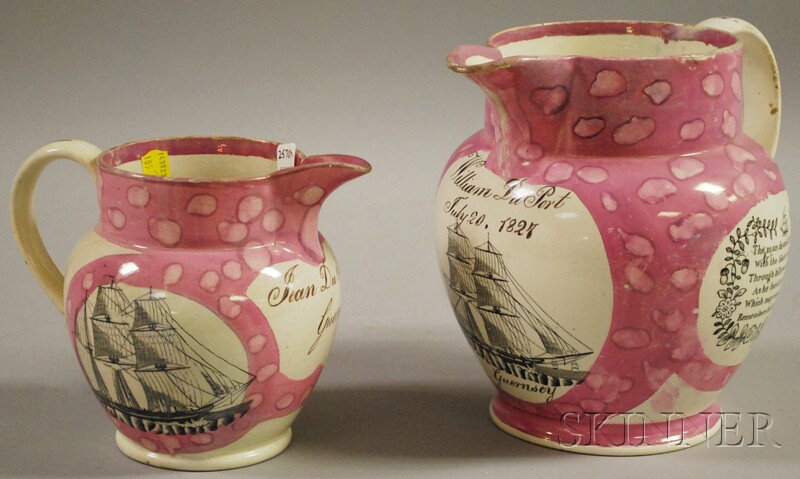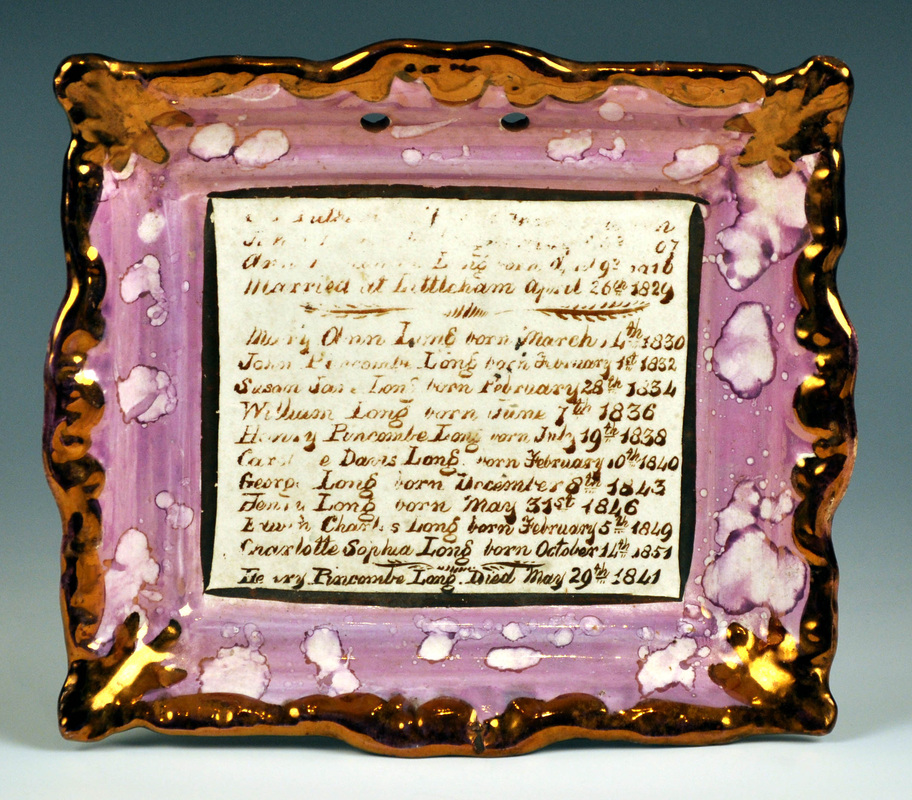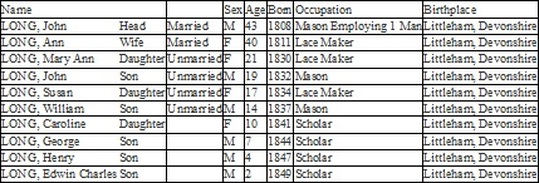|
2/16/2013 0 Comments The Long family historyOne of the things I love about plaques is imagining who owned them before me, what kind of rooms they hung in, and what they might have meant to their owners. A dealer once told me that they really belonged in rural cottages. But given the mass migration from the countryside to cities in the 19th century, they just as likely hung on the walls of a terraced two up, two down. Dick Henrywood has referred to plaques as 'Poor Man's Pictures' - the title of his two articles for Antique Collecting (November 2004, March 2005). My friend, Stephen Duckworth, has been doing some fascinating research into who bought religious Staffordshire figures - presented recently to the English Ceramics Circle. Given the prices of figures and incomes in the 19th century, he suggests that the lower middle classes - skilled trades, lower ranking office workers and the like - were the most likely market for such wares. Stephen says those on higher incomes might have bought pottery for servants quarters or for the nursery. What better to keep servants and children in check, or paying visitors in a guest house, than a 'Thou God Sees't Me' plaque on the wall? (Perhaps George Orwell had such a plaque in mind when he coined the slogan 'Big Brother is Watching You'.) An obvious market for maritime plaques and verses would be for the families of sailors. Indeed, sailors stopping off at Sunderland might well have bought such presents and keepsakes to take home with them. Maritime jugs, for instance, appear with inscriptions relating to Guernsey families. See two below that came up at Skinner Auctioneers recently. Now, the reason I'm posting all of this is that Norman Lowe recently contacted me regarding a plaque I own with a hand-painted history of the Long Family. It is a Dixon plaque with hand-painted birth dates. It starts with a marriage date, and ends with a death. It must have been made after 1851: the most recent birth date on the plaque. Norman cleverly tracked the Long family down in the 1851 census, and found them living at 48, Albion Street, Withy Combe Rawleigh, Exmouth, Devon (see below). I have transcribed the text from the plaque beneath the census information. There are some slight variations in the dates, but they are clearly the same family. The first three lines indistinguishable... Married at Littleham April 26th 1829 ///// Mary Ann Long born March, 4th 1830 John Puncombe Long born February 1st 1832 Susan Jane Long born February 28th 1834 William Long born June 7th 1836 Henry Puncombe Long born July 19th 1838 Caroline Da...s Long born February 10th 1840 George Long born December 8th 1843 Henry Long born May 31st 1846 Edwin Charles Long born February 5th 1849 Charlotte Sophia Long born October 14th 1851 ///// Henry Puncombe Long. Died May 29th 1841 So it looks as if John and Anne were married at Littleham in 1829, when he was 21 and she was 18. They had their first child, Mary, a year later. By 1851, just before when the plaque was made, there were 10 of them living at the same address. Their third child, Henry, died in 1841, not yet 3 years old. But a new child, Charlotte, was born shortly after the census, bringing the household total to 11. John Long was a mason employing one man. His boys are also listed as masons, working from as young as 14. The girls worked as lace makers. The younger children are charmingly listed as scholars. John perhaps commissioned the plaque, satisfied that his procreative duty was done and there would be no more children. His 40 year old wife, Anne, after giving birth to 10 children, was probably mightily relieved! Courtesy of Google Street View and maps, you can see the three-story town house that they lived in. Zoopla tells us it probably had about 5 or 6 bedrooms, and today would be worth about £170,000. By Victorian working standards, the Longs would have been relatively well off. Precisely the market that Stephen Duckworth had supposed. Perhaps father and eldest son, John, drank in the Exmouth Arms around the corner, after a hard day's masonry, and the family went to Exmouth Chapel on Sundays.
The Long family have no obvious maritime link, so perhaps the plaque was commissioned through a local distributor, or a sailor carried the instructions to earn some money on the side. See the Plaques with hand-painted text page for more plaques with a South West of England link, commissioned for the Quick family in the 1870s. Huge thanks to Norman for supplying me with the census details. I appreciate the magic of the plaque even more than I had done previously, and I wouldn't have thought that was possible.
0 Comments
Leave a Reply. |
AuthorStephen Smith lives in London, and is always happy to hear from other collectors. If you have an interesting collection of plaques, and are based in the UK, he will photograph them for you. Free advice given regarding selling and dispersal of a collection, or to those wishing to start one. Just get in touch... Archives
February 2022
AcknowledgementsThis website is indebted to collectors, dealers and enthusiasts who have shared their knowledge or photos. In particular: Ian Holmes, Stephen Duckworth, Dick Henrywood, Norman Lowe, Keith Lovell, Donald H Ryan, Harold Crowder, Jack and Joyce Cockerill, Myrna Schkolne, Elinor Penna, Ian Sharp, Shauna Gregg at the Sunderland Museum, Keith Bell, Martyn Edgell, and Liz Denton.
|


